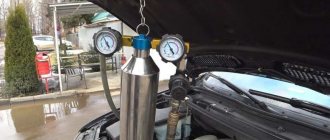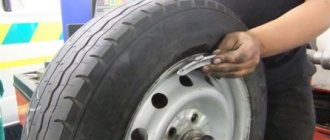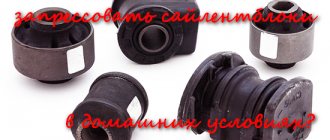There is an opinion that rubber dye is intended to give tires an aesthetic appearance, giving them shine and creating the effect of “new” tires. This move will leave the girl or car buyer impressed. In fact, tire ink has protective properties. Rubber wears out and breaks down over time under the influence of the environment and chemical road reagents. Rubber ink creates a protective layer that is absorbed into emerging microcracks and defects, which significantly slows down rubber wear.
Is it necessary to buy an expensive tire ink or can you make an effective composition yourself? There are many ways to prepare an inexpensive “folk” remedy at home. To obtain maximum effect, the main condition for applying the composition to tires is their cleanliness.
Rubber before and after blackening
Requirements for a homemade tire ink:
- Resistant to water washability;
- No corrosive effects on metal parts of the car;
- Quick application and renewal of rubber products;
- No negative impact on plastic parts;
- Ease of manufacture and use;
- Availability of materials and their low cost.
Why blacken rubber?
A number of car owners are perplexed by the process of blackening wheels. In their opinion, it will be enough to wash them well. In fact, people who are economical and knowledgeable about this are trying to extend the service life of rubber, which is the one that is subject to the greatest loads during operation. The procedure for blackening wheels is comparable to the process of caring for shoes. A special protective cream not only gives shoes shine, but also extends their service life. The blackening process is a kind of care for car “shoes”.
The condition of Russian roads, dirt, and crushed stone have a negative impact on the condition of tires, providing them with microcracks and abrasions. Salt and chemicals used in the treatment of city roads also contribute.
Applying blackening to the surface of tires for a certain period of time copes with these problems and creates a layer that protects the surface of the tires from aggressive influences, as well as from fading in the sun, cracking, and the adhesion of dirt and dust.
Inks add shine to tires and protect them from dirt, cracks, and fading.
Most common inks are easy to apply, work instantly and keep your tires in good shape. Such compounds stay on the surface of tires for about a week, depending on the intensity of vehicle use, weather and road surface.
Recommendations from tire blackening specialists
If you follow the recommendations of experts, then it is better to use professional products for blackening tires. This is explained by the fact that such substances not only give the wheels an attractive appearance, but also absorb into the rubber and protect it. Cheap store-bought products, including homemade ones, practically do not protect tires, and with frequent use, on the contrary, they worsen the properties of rubber. In addition, depending on the composition used, it may not be absorbed and during movement it may stick to the body, arches, or bumper, resulting in dust spots.
Surface preparation and blackening procedure
Before blackening rubber, dirty tires should be washed and dried, and dusty tires should be blown with pressurized air or dust removed in another way. The ink is applied to a clean, dry surface in an even, thin layer. During the procedure, excess mixture is removed with a sponge, brush or rag. The entire process of applying ink does not take even 10 minutes.
After completing the procedure, it is not recommended to immediately operate the car on a wet road; you must allow the product to dry thoroughly. If all surface preparation conditions are met and the blackening process is carried out correctly, the substance on the surface of the tires will last longer.
Special compositions for blackening
In winter, it is advisable to use silicone-based solutions, and in summer, water-based ones. All factory inks are conventionally divided into 2 large groups.
Table. Types of store-bought inks.
| Name | Short description |
| Shiny | These are silicone-based lubricating compounds, after application of which the rubber becomes beautiful and shiny. But the shine and attractive appearance disappear when dust adheres to the tires. |
| Matte | They can be applied not only to rubber, but to the entire car. The rubber eventually takes on a deep black color. But it is worth knowing that the effect is short-lived and that after contact with water the appearance will be even worse than before blackening. |
Let's consider the most popular inks, highlighted among the whole variety of products.
"Black gloss" . This product is often used in car washes. When applied, the substance is sprayed onto the tire, after which you need to wait about 10 minutes. There is no need to wipe anything. Thanks to this treatment, the color of the rubber is improved, it is protected from dirt and dust, and cracking is prevented. Average market price – from 480 rubles.
"Black gloss" is one of the most popular inks
Dannev . A high-quality color restorer that provides a rich black color to rubber for 48 hours in rainy weather. The wet shine effect is short-term, in addition, there is no protective layer and protection from UV rays. The price of one 250 ml bottle is approximately 260 rubles.
Dannev color restorer
XADO Red Penguin . After treating the wheels with this product, they become very attractive. Lasts quite a long time, costs an average of 420 rubles. for 1 l.
DoctorWax . Effectively restores rubber by eliminating small defects and filling microcracks. Can be used not only for wheels, but also for mats. Reliably protects plastic and rubber, gives them shine, and is used quite economically. But the effect is short-term, especially in case of rain. A 300 ml bottle of the product will cost at least 250 rubles.
Tire restorer DoctorWax
HI-GEAR HG5331 . This is a conditioner cleaner that is best used only on tire moldings and sidewalls. If the product gets on the plastic/body, it must be removed immediately with a dry, clean cloth. What is typical is that the product can only be applied at a temperature of +15–25˚С. There is no shine effect. Approximate price – from 450 rubles.
HI-GEAR HG5331 forms a dirt- and moisture-repellent film
Blackening of rubber with glycerin
The most common ink recipe is a glycerin-based one. This thick transparent liquid can be purchased at your nearest pharmacy at a very affordable price (8-20 rubles per bottle). The capacity of one bottle is 25 ml, but there are also larger ones. For one application procedure, 5 – 7 bottles are enough.
Glycerin is one of the most common tire blackening agents.
The composition of 5 - 7 bottles is mixed with plain water. Typically, glycerin is diluted with water in a 1:1 ratio , but there are no clear proportions. To obtain a fattier composition, use a ratio of 3:5 (water/glycerin). The result will be a thicker mixture, but the quantity will be smaller. To increase the amount of composition, use a ratio of 8:5 (water/glycerin).
The ratio can be anything depending on the imagination of the car enthusiast. The main thing is not to go too far with concentration. In general, the rule is this: the more glycerin, the more shiny the tires will be . However, road dust will stick to them more easily, and a strong concentration of this substance can negatively affect the condition of the tires.
Comparison of tire gloss depending on the proportions, where 1:1, 1:3, 1:5, 1:7 - glycerin: water
The resulting mixture is poured into a container with a sprayer. A glass cleaner container is suitable for this purpose.
The product is applied to tires in one of two ways:
- If the composition has a high fat content, it is sprayed onto a sponge and rubbed on the tire;
Applying a thick glycerin solution to tires
- With a liquid composition, spray it onto the rubber and rub it into the tire with a sponge.
Applying liquid glycerin solution to tires
Advantages of choosing this ink:
- Low cost and availability of mixture components;
- Possibility of frequent use of this blackening method;
- Speed of the blackening process;
- The composition is also suitable for applying to a black car bumper.
The disadvantages of glycerin-based ink include:
- The result is not durable - the fat content of glycerin first gives shine to the tire, and then attracts dust. Also, after the first wash of the car, the former shine will disappear. Ideally, the shine will last about a week;
- When applied to the bumper, the shine lasts until the first rain;
- A high concentration of glycerin has a negative impact on the condition of the rubber (if the above proportions are observed, there will be no harm to the rubber).
How to make tire ink yourself: the best ways
Proper car care involves a whole range of procedures: washing the body and cleaning the interior, treating seals and locks, lubricating door hinges, and also caring for tires. In this case, tires require additional processing for the following reasons:
Car tires are treated using compounds known as wheel blackeners. This product is based on glycerin. There are a large number of similar products on sale from various manufacturers, but the main disadvantage is their cost. A more cost-effective alternative is to make your own rubber dye. Read more in our article.
Blackening with laundry soap
Regular laundry soap, available in every home, can save the situation. To prepare the ink, laundry soap is cut into pieces or grated. Water is poured into a container with crushed soap. After the soap has dissolved, the working fluid is ready.
To apply the composition to tires, a brush with medium hardness (about 70%) is suitable. Clean tires are rubbed with the resulting mixture, or soap is lathered directly onto a brush and rubbed into the rubber with active movements. The rubber will be black, like new.
Blackening rubber with laundry soap
The advantages of the method include simplicity, availability of funds and speed of application. This method has one drawback - you cannot often use laundry soap , as it dries out the rubber and reduces its service life.
What is the difference between inks in composition and price
The difference in price is determined primarily by the set of components and the volume of the cylinder. Conventionally, inks can be divided into professional and consumer. In addition, the price is affected by:
- the presence of softening components in the set to make the rubber plastic;
- the presence of additives for filling microcracks;
- the presence of additives for capillary penetration into rubber;
- adding so-called optical filters to reduce the proportion of dye in the composition.
The ink is based on modified glycerin or silicone. They are similar in properties and restore the condition of rubber and soft plastics well. Rubber ink made from glycerin can be thicker than silicone.
Blackening with shoe polish
For blackening rubber, colorless gloss, liquid black shoe paint, and dark-colored shoe polish are perfect. It is worth choosing a cheaper product.
Before applying the cream, the tires are washed and dried. A shoe brush, sponge or foam rubber is suitable for applying to dry rubber. After application, a good result is obtained, and the paint lasts a relatively long time.
Blackening rubber with shoe polish
This method has one drawback - you cannot drive immediately after application, the cream must dry after application, you will have to wait at least 10 minutes.
Algorithm of actions
To reproduce the blackening of rubber, you need to take an old toothbrush or some other one that can penetrate all hard-to-reach places. After cleaning the tires, you can proceed directly to the blackening process itself. To do this, you will need a spray bottle with treatment liquid (for convenience, prepare it in advance). The process of applying the product should involve rubbing it into the tire - this will give you the best effect. Next, you need to wait a few minutes until the liquid is completely dry.
The liquid, which has a foam base, must wait about 20 minutes to dry.
In order to consolidate the effect, it is recommended not to leave for about half an hour to allow the liquid to completely absorb and dry.
Advertisement
On the information site for car enthusiasts "FORAM" you can find a lot of useful information regarding car repair and maintenance.
Blackening of rubber with PMS silicone - 200
Silicone oil PMS-200 is used for blackening tires. There are no problems with the method of applying and preparing the composition. After washing the wheels, silicone is applied to a sponge or brush and rubbed into the tires.
Silicone oil is considered one of the best available means for blackening rubber.
The ink will last a relatively long time, but choosing this method will cost more, although a liter of silicone will last for a year even with frequent use. This substance is also suitable for storing tires. It is enough to apply the substance to their surface. Among all the homemade inks, this one is considered the best option.
Do it yourself or go to a service center
Of course, it’s easier to go to a car service center, and there they will quickly and efficiently carry out the blackening procedure. But such a procedure is not cheap, and you will have to pay a hefty amount. Many car owners manage to blacken tires themselves, at home. There are special products for this that are sold in any specialized store. But they are not cheap either. In this case, there is another option - to make your own rubber ink. In order to make a tire blackening agent, you need:
- Shoe shoe
- Silicone
- Laundry soap
- Glycerol
As you can see, from ingredients that are often used in everyday life, you can prepare a composition that is very expensive in the store.
Of course, the service center will carry out the procedure professionally; in addition, they will thoroughly and thoroughly wash the tires and dry them. After blackening the tires at the service center, you can quickly go home. But if you carry out the procedure at home, and even with a product that is made manually, from improvised means, you will have to wait much longer.
Rubber ink from Coca-Cola
One of the most accessible methods is that you can buy soda at “every step.” Rub the soda into the surface of the tires with a sponge. Almost any similar sweet drink will do. Instead of soda, you can use dishwashing or glass washing gel.
You can even use Coca-Cola to blacken rubber, but the effect will only last a couple of days.
This method has its disadvantages:
- The tires will be sticky for several hours, which means you will have to hold off on traveling during this time (with the exception of dishwashing gel or glass);
- On average, blackening lasts only 2 – 3 days.
Blackening with beer and sunflower oil
Blackening of tires with beer and sunflower oil is not widespread. The reason for this was the stickiness of the tire surface for a long time. The effect after applying beer and vegetable oil was only in the first moments while the car was standing. After the first trip, dust and fluff covered the tires in a dense layer.
Theoretically, tires can be blackened with beer or sunflower oil, but the effect of this is very doubtful, and excess dust and dirt will stick to the tires
Dirty business
After treatment with the listed acids, it is better to apply a protective layer, for which tire blackeners that contain chemically neutral silicones, waxes and polymers are suitable. They fill cracks, give the rubber an even black color, cover it with a water-repellent film, and prevent further cracking.
The film dries and can last for several weeks if you do not drive your car into puddles or mud. For comparison, you can treat one wheel with ink and then monitor how the coating behaves. The color difference will persist for a long time.
Most often, ink is sold in spray form. Tire polish must be applied without smudges or rubbing. In about ten seconds, one wheel can be processed. The frequency of application of the chemical composition is twice a month. A half-liter bottle is enough for about two to three treatments.
Blackening of rubber with shoe polish and solvent
This method is used in the military environment - “cheap and cheerful.” The mixture is used to rub tires on trucks and wheeled combat vehicles. The mixture is obtained by pouring the solvent into a metal container, and shoe polish is added there. The resulting composition is mixed and heated to a boil.
Next, the resulting mixture is applied to the tires. The tires become like new.
Disadvantages of the method:
- The blackening is enough for literally one or two trips;
- Shoe polish dries the rubber, which leads to increased wear.
In general, it is not recommended to use this method due to its fragility and even harm to tires.
Solvent shoe polish is also not the best option for blackening rubber.
This method is based on mixing waste oil with a solvent, diesel fuel with bitumen or soot, but without subsequent heating. This composition of components is present in almost every garage. The disadvantages of these methods are the same as for the shoe polish + solvent composition.
How much does it cost to blacken tires?
The cost depends on their manufacturer, and secondarily on the type of substance. They are produced in different forms (spray, foam, mastic and liquid), but in terms of the final result there is often no difference which one to use. Some are based on oils, some are based on solvents, but you should choose a high-quality composition so that it does not harm the tires. If you choose a reliable one, then the result will be good.
When choosing a type, it all depends on how convenient it is for a person to apply it directly to the wheels. After all, the applied layer should not be too thick, and also not leave the tire during application. If the substance gets on the car's paint, there is no guarantee that it can be easily washed off. Therefore, if you use a spray to blacken the wheels, you will have to cover part of the wings and wheel arches.
They are easy to find at auto stores, but some people like to replace them with various home remedies, which is not recommended. The reason is simple: it is difficult to predict how a homemade spray will affect the characteristics of rubber. The cost of a spray in a car shop in Moscow is about 300–800 rubles, and foam - from 250 rubles and more.
Petroleum solvent and gasoline "Galosha"
Less common methods are the use of solvents such as Nefras or B-70 gasoline. Tires rubbed with such compounds acquire a black matte surface to which dust does not stick.
Nefras can cope well with blackening of rubber
The solvent is rubbed into the surface of the tires with a sponge or brush. This method is not widely used due to the fact that not many people want to see their car tires in a matte “light” and the above solvents are not popular in principle.











